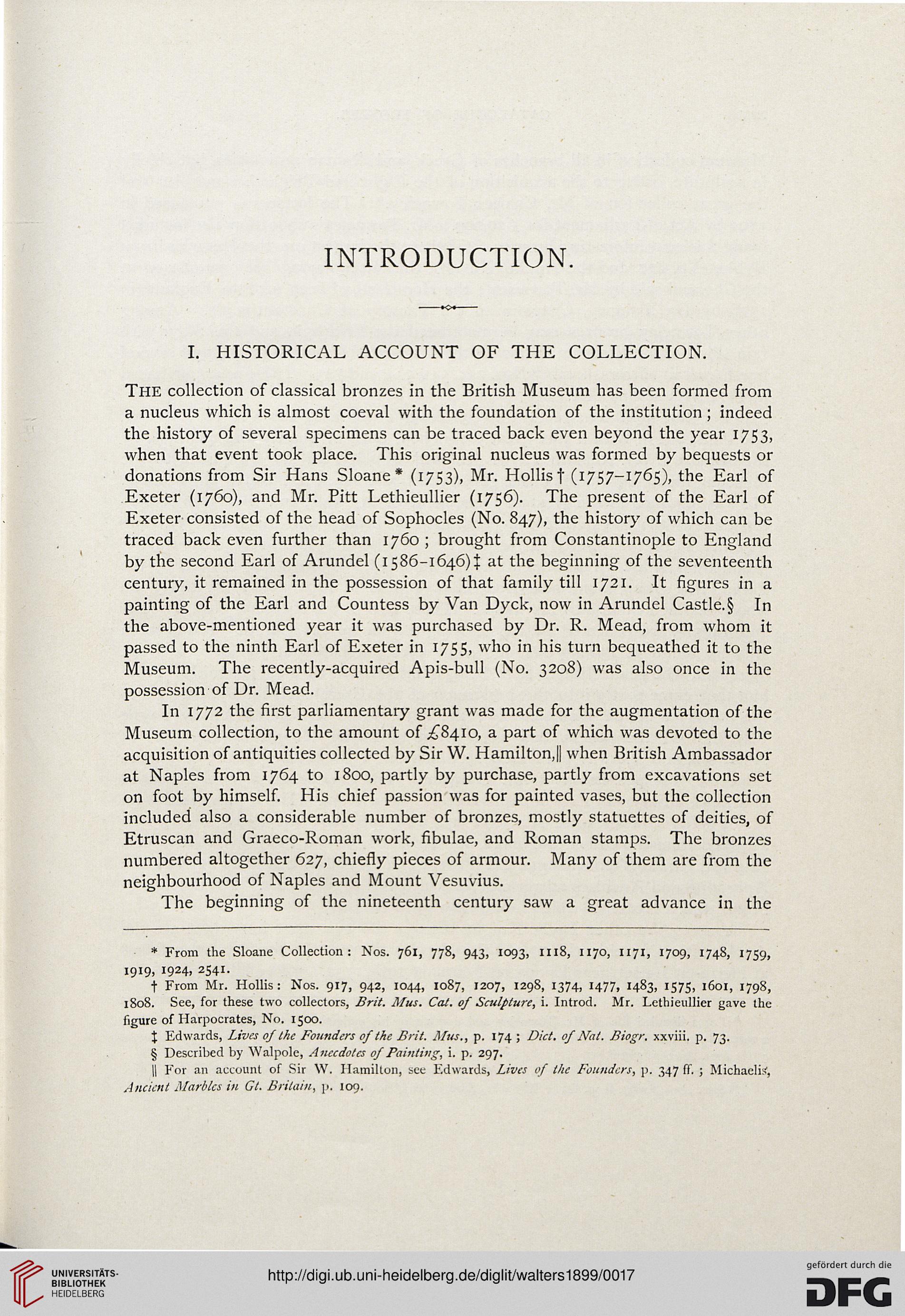INTRODUCTION.
I. HISTORICAL ACCOUNT OF THE COLLECTION.
Ti-IE collection of classical bronzes in the British Museum has been formed from
a nucleus which is almost coeval with the foundation of the institution ; indeed
the history of several specimens can be traced back even beyond the year 1753,
when that event took place. This original nucleus was formed by bequests or
donations from Sir Hans Sloane * * * § (1753), Mr. Hollist (1757-1765), the Earl of
Exeter (1760), and Mr. Pitt Lethieullier (1756). The present of the Earl of
Exeter consisted of the head of Sophocles (No. 847), the history of which can be
traced back even further than 1760 ; brought from Constantinople to England
by the second Earl of Arundel (1586-1646)! at the beginning of the seventeenth
century, it remained in the possession of that family till 1721. It figures in a
painting of the Earl and Countess by Van Dyck, now in Arundel Castle.§ In
the above-mentioned year it was purchased by Dr. R. Mead, from whom it
passed to the ninth Earl of Exeter in 1755, who in his turn bequeathed it to the
Museum. The recently-acquired Apis-bull (No. 3208) was also once in the
possession of Dr. Mead.
In 1772 the first parliamentary grant was made for the augmentation of the
Museum collection, to the amount of ^8410, a part of which was devoted to the
acquisition of antiquities collected by Sir W. Hamilton,|| when British Ambassador
at Naples from 1764 to 1800, partly by purchase, partly from excavations set
on foot by himself. His chief passion was for painted vases, but the collection
included also a considerable number of bronzes, mostly statuettes of deities, of
Etruscan and Graeco-Roman work, fibulae, and Roman stamps. The bronzes
numbered altogether 627, chiefly pieces of armour. Many of them are from the
neighbourhood of Naples and Mount Vesuvius.
The beginning of the nineteenth century saw a great advance in the
* From the Sloane Collection : Nos. 761, 778, 943, 1093, 1118, 1170, 1171, 1709, 1748, 1759,
1919, 1924, 2541.
t From Mr. Hollis: Nos. 917, 942, 1044, 1087, 1207, 1298, 1374, 1477, 1483, 1575, 1601, 1798,
1808. See, for these two collectors, Brit. Mus. Cat. of Sculpture, i. Introd. Mr. Lethieullier gave the
figure of Harpocrates, No. 1500.
t Edwards, Lives of the Fomiders of the Brit. Mus., p. 174 ; Dict. of Nat. Biogr. xxviii. p. 73.
§ Described by Walpole, Anecdotes of Painting, i. p. 297.
|| For an account of Sir W. Ilamilton, see F.dwards, Livcs of thc Foundcrs, p. 347 ff. ; Michaelis',
Ancicnt Marblcs in Gt. Brilaiu, p. 109.
I. HISTORICAL ACCOUNT OF THE COLLECTION.
Ti-IE collection of classical bronzes in the British Museum has been formed from
a nucleus which is almost coeval with the foundation of the institution ; indeed
the history of several specimens can be traced back even beyond the year 1753,
when that event took place. This original nucleus was formed by bequests or
donations from Sir Hans Sloane * * * § (1753), Mr. Hollist (1757-1765), the Earl of
Exeter (1760), and Mr. Pitt Lethieullier (1756). The present of the Earl of
Exeter consisted of the head of Sophocles (No. 847), the history of which can be
traced back even further than 1760 ; brought from Constantinople to England
by the second Earl of Arundel (1586-1646)! at the beginning of the seventeenth
century, it remained in the possession of that family till 1721. It figures in a
painting of the Earl and Countess by Van Dyck, now in Arundel Castle.§ In
the above-mentioned year it was purchased by Dr. R. Mead, from whom it
passed to the ninth Earl of Exeter in 1755, who in his turn bequeathed it to the
Museum. The recently-acquired Apis-bull (No. 3208) was also once in the
possession of Dr. Mead.
In 1772 the first parliamentary grant was made for the augmentation of the
Museum collection, to the amount of ^8410, a part of which was devoted to the
acquisition of antiquities collected by Sir W. Hamilton,|| when British Ambassador
at Naples from 1764 to 1800, partly by purchase, partly from excavations set
on foot by himself. His chief passion was for painted vases, but the collection
included also a considerable number of bronzes, mostly statuettes of deities, of
Etruscan and Graeco-Roman work, fibulae, and Roman stamps. The bronzes
numbered altogether 627, chiefly pieces of armour. Many of them are from the
neighbourhood of Naples and Mount Vesuvius.
The beginning of the nineteenth century saw a great advance in the
* From the Sloane Collection : Nos. 761, 778, 943, 1093, 1118, 1170, 1171, 1709, 1748, 1759,
1919, 1924, 2541.
t From Mr. Hollis: Nos. 917, 942, 1044, 1087, 1207, 1298, 1374, 1477, 1483, 1575, 1601, 1798,
1808. See, for these two collectors, Brit. Mus. Cat. of Sculpture, i. Introd. Mr. Lethieullier gave the
figure of Harpocrates, No. 1500.
t Edwards, Lives of the Fomiders of the Brit. Mus., p. 174 ; Dict. of Nat. Biogr. xxviii. p. 73.
§ Described by Walpole, Anecdotes of Painting, i. p. 297.
|| For an account of Sir W. Ilamilton, see F.dwards, Livcs of thc Foundcrs, p. 347 ff. ; Michaelis',
Ancicnt Marblcs in Gt. Brilaiu, p. 109.




